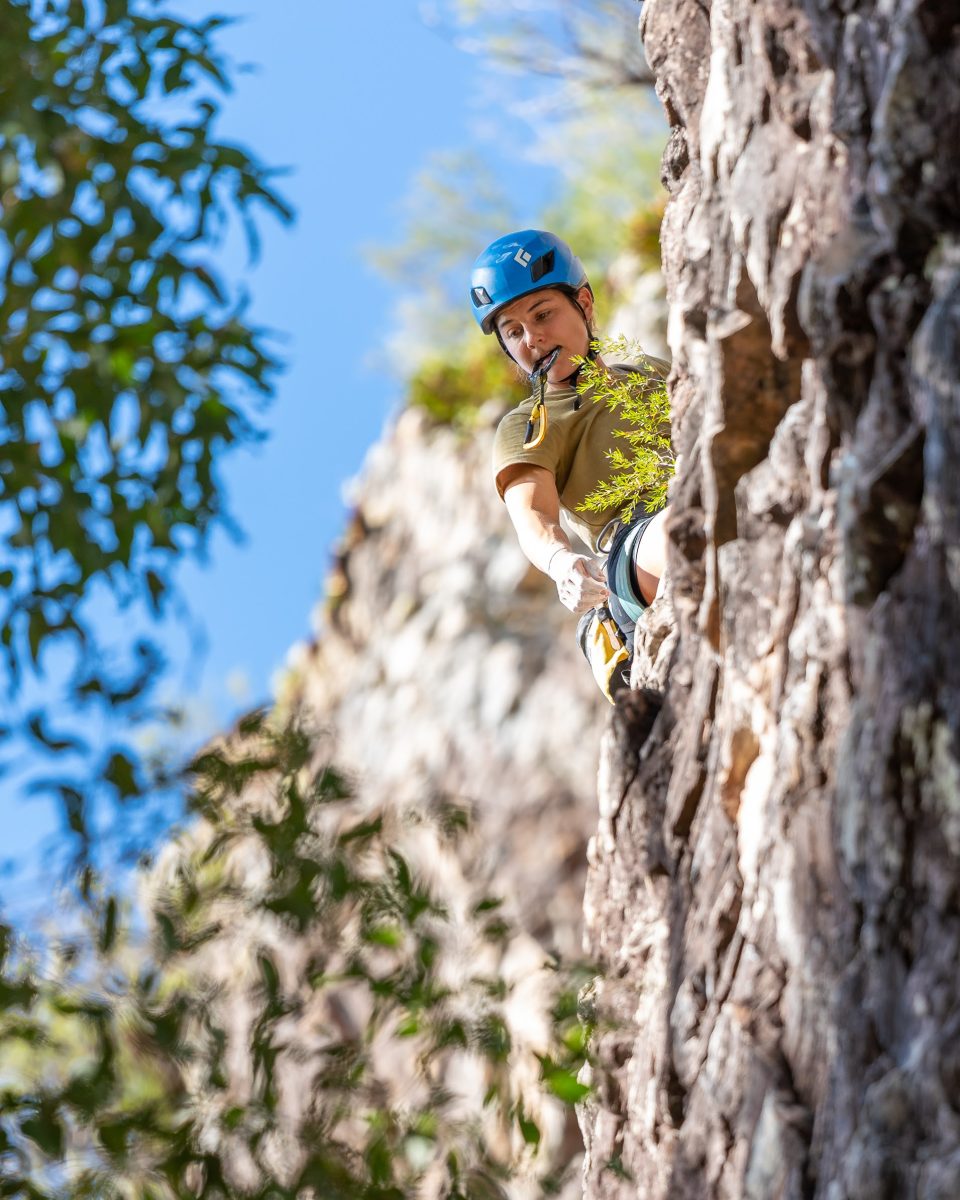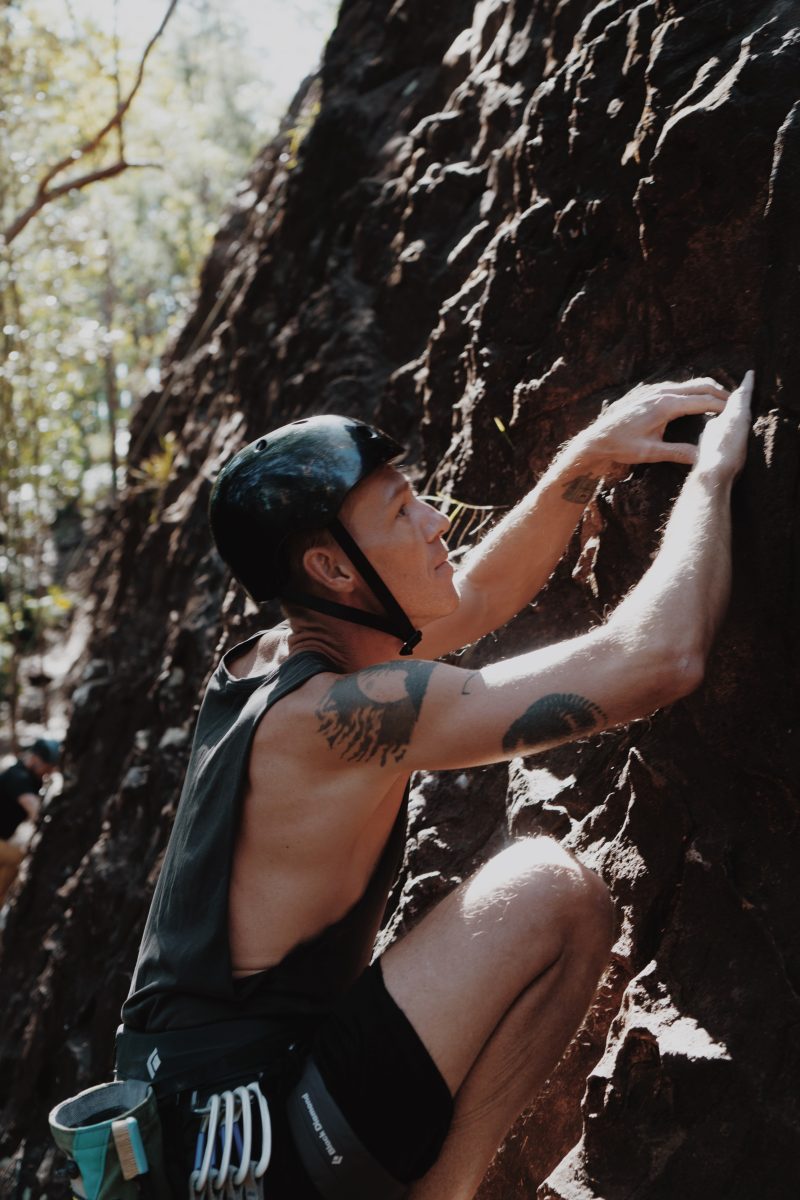Outdoor Essentials for Sport Climbing

It’s a calling, a pull, a drive. A desire to climb on real rock in the great outdoors, surrounded by stunning mountains and vertical stone. You’re not alone if outdoor climbing excites you! It was the birthplace of our wonderful sport, so it’s only natural that new climbers want to make the jump outdoors.
At Alpine Indoor Climbing we want to help get you climbing on stone, with both the proper skills and equipment.
Now for the gear! We want to make this process seamless and eliminate the frequently asked questions. That is why we have put together a comprehensive gear-list with all the essentials (and add-ons) you’ll need for outdoor climbing.
SPORT CLIMBING ESSENTIALS
Quickdraws
Be sure to experiment with what gate-types, dogbone widths and quickdraw lengths you like best, before purchasing your own set. Shorter climbers should invest in a few longer length quickdraws to make reachy clips easier.

Rope
Arguably the most important piece of equipment, as without one your are simply ‘Free Soloing’… A 60m rope is a great starting length and will suit most crags, allowing you to climb routes with a maximum height of 30 metres. But as modern crags become increasingly tall, 70 metre and even 80 metre ropes are becoming more common.
Slings
Sewn Slings are useful for extending clips and creating anchors, so be sure to have a few in your pack. They come in a variety of widths and lengths, but to start off you will want to get 2-3 double and single arm-length slings.
Single-arm length slings (60cm) can be racked with two carabiners to become an ‘Alpine Draw’, and when extended are considerably longer than a standard quickdraw. Double Arm-Length Slings (you guessed it… 120cm) are great for building anchors for multi-pitch or top-rope climbing.

Belay Device
Every climber should have a belay device, or two, and know how to use it. There are two basic types on the market, the standard belay device and assisted braking devices. Standard Belay Devices, Such as Tubular, Guide or ATC devices are versatile and simple – plus climbers can rappel on most of these. Assisted Braking Devices, such as the GriGri or Revo, are engineered to automatically block the rope when force is applied, adding an extra level of safety to belaying.
Locking Carabiner
These are standard carabiners that can be locked in a closed position for safety, either using a screw-gate or magnets. Make sure to have 2-3 Locking Carabiners as they are essential for belaying, anchoring and cleaning routes.

Non Carabiner
It’s always useful to have 3 or more lightweight non-locking carabiners, and keep a couple of your harnesses while climbing. Whether you are building an anchor, clipping a cordelette or securing personal gear, it’s not hard to find a use for these guys!
Crag Bag
Simplicity is key here. Rock Climbing is a gear intensive sport, so it helps to have a bag that you can load up for the approach and unpack easily at the crag. Usually a 20-30 Litre Daypack will do for most crag days, but for longer approaches consider a backpack with increased support and a higher literage.
Rope Bag
Rope bags do two things exceptionally well; allow us to transport our ropes easily and keep our ropes clean from dirt and moisture. By ensuring our ropes stay dry and clean, we can prolong its life-span and protect our equipment from excessive wear caused by dirt/sand. Instead of having to lap-coil your rope when travelling between crags or routes, you can simply flake the rope into your rope-bag and it’s ready to go!
PERSONAL GEAR
Climbing Shoes
When first beginning your outdoor climbing journey, you’ll find yourself spending longer periods on the wall as you learn valuable skills – so get a comfy pair of climbing shoes! You’ll want a climbing shoe that has a neutral profile and isn’t too soft, so you can keep them on for longer durations and stand comfortably on small edges. As you begin progressing towards harder climbs it’s time to start looking at more aggressive shoe models for increased accuracy and power.
Climbing Harness
To keep you safe and store climbing equipment you will need a comfortable and durable harness. Make sure it has at least four gear-loops for clipping quickdraws and personal equipment, along with adjustment buckles to fine-tune waist and leg-loop size. For rappelling, projecting or simply sitting in your harness for long periods of time, it helps to find a model that has added cushioning around the waist and any ‘pinch points’.
Chalk Bag
When the conditions aren’t quite perfect, you’ll be glad to have some chalk on hand. Make sure you get a model that closes securely for travel and has a brush-holder for cleaning crimps and slopers.
Helmet
Unfortunately it’s not uncommon to encounter loose rock, or ”choss”, at less-travelled or newer climbing crags. So be sure to have a helmet and put it on once you get to the wall, this is especially important for your belayer. Should you dislodge rock while climbing, be sure to alert your belayer and any nearby climbers with a loud “ROCK!!!”.
ADDITIONAL EQUIPMENT & ACCESSORIES
Climbing Guide
Although digital guides, such as TheCrag.com, are fastly becoming the norm, nothing quite beats paper. A well-made climbing guide will help you approach the crag and find climbing routes easily, making them invaluable for those visiting cliffs for the first time!
Belay Glasses
Save your neck while giving your mates catches on their projects! Belay glasses allow you to keep eyes on the climber without the pain-staking neck workout.
Stick-Clip
A stick-clip allows you to easily pre-clip the first bolt for a climber, eliminating the initial risk of a ground fall. These gadgets are particularly useful at a crag with high first bolts, and most modern crags are bolted with stick-clipping in mind (though a long stick always works well!).
Water Bottle
Stay hydrated on the approach and while at the crag by bringing plenty of water on your next outing.
Snacks
Try not to get so excited about a day of climbing that you forget to pack a bite to eat – trust me, we’ve all done it… Instead, ensure you are fueling your body with calories throughout the entire day to remain psyched and perform at your max.
Tape
Invaluable. Whether you have a nasty flapper that needs bandaging or you’re ‘MacGyver-ing’ an equipment fix, Climbing Tape does it all!
Knife / Multi-tool
It helps to be the one with the knife, so make sure you have one easily accessible for emergencies or to whip up some lunch!
Extra Layers
When it’s getting cold, keep the core temperature high while resting on the ground between burns with a cosy jacket or fleece. On the sunny days, a long sleeve shirt and hat are essential for escaping the UV.
And don’t forget to slip, slop, slap!
Skin Care Kit
A must-have kit for those climbing on rough or coarse terrain, as you can keep your skin healthy and happy at the crag. A proper ‘Skin Care Kit’ should have nail clippers, tape, a sanding block and some skin cream or balm.
Medical Kit
Anyone entering into the wilderness, for a hike or climb, should have a comprehensive medical kit in their backpack. Make sure it’s easily accessible and you are familiar with basic first-aid techniques in case of an emergency.
So what are you waiting for? Go explore the vertical, but make sure you have all the gear and skills needed for a great day out! We have a range of climbing equipment at Alpine Indoor Climbing Gym to help you get outdoors.